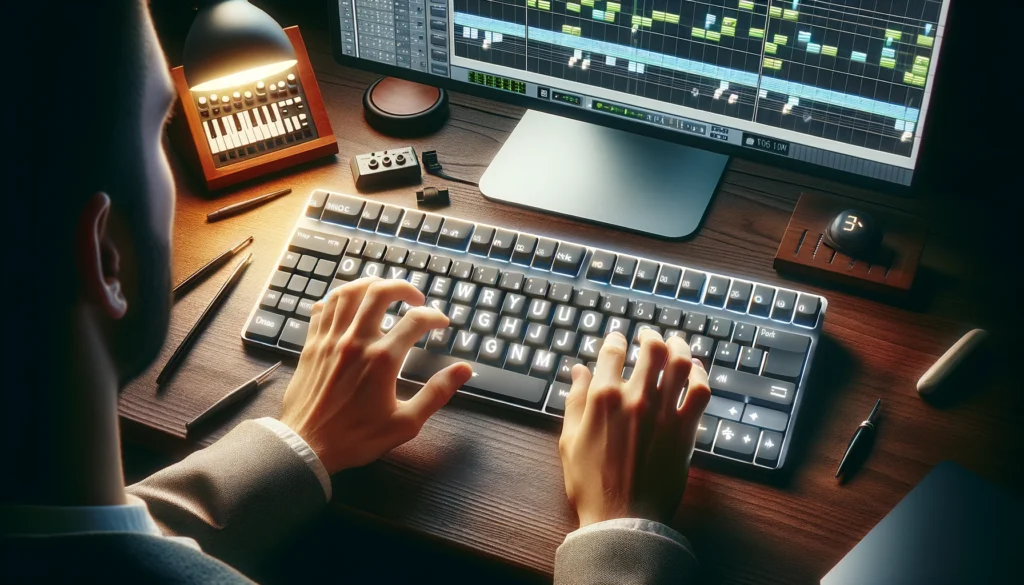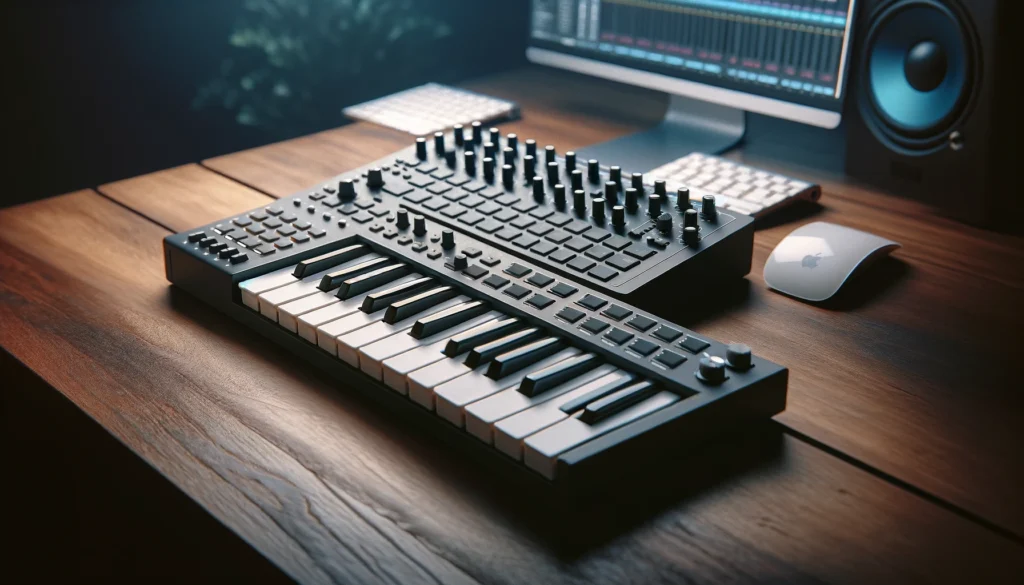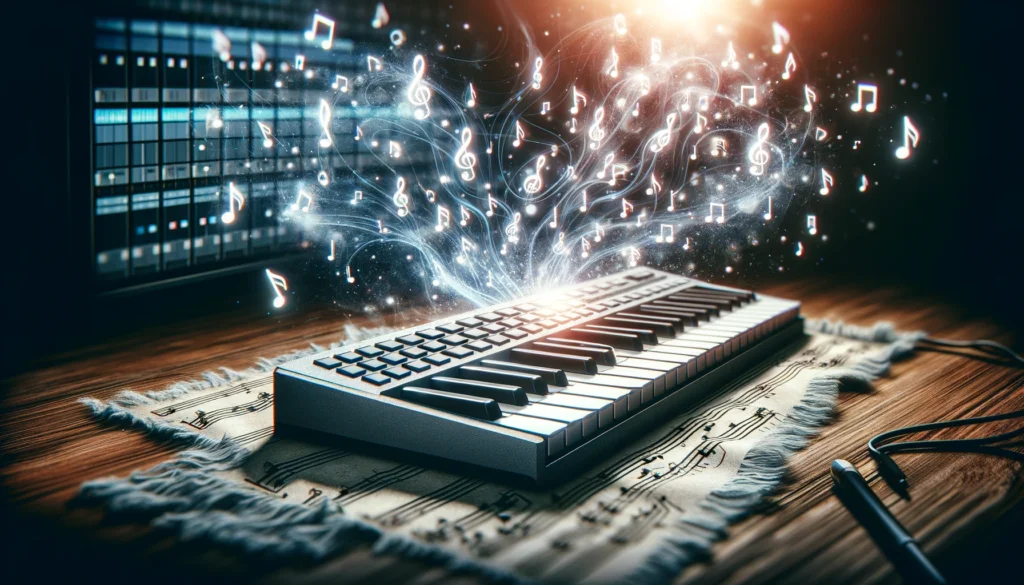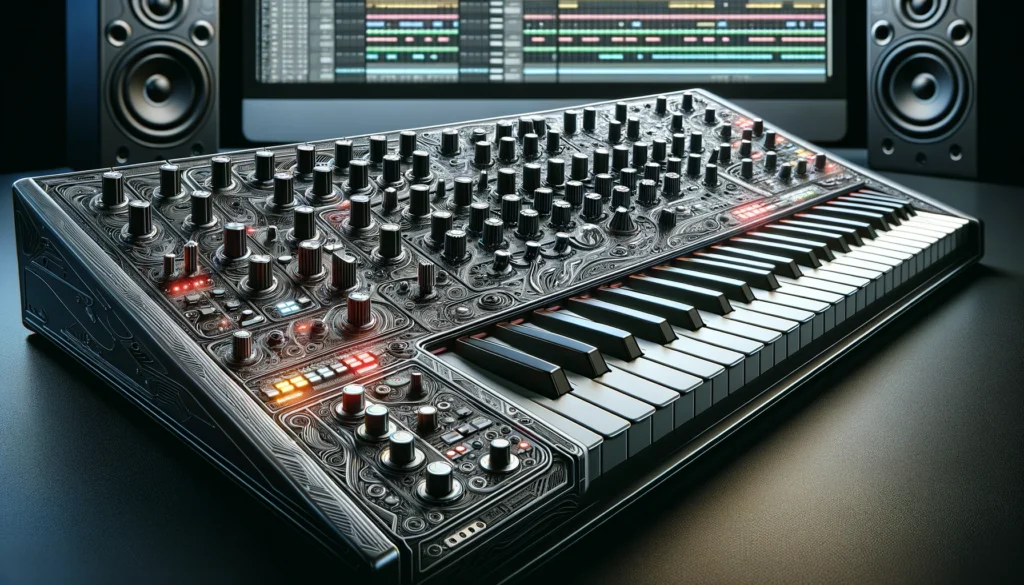Struggling to afford an expensive MIDI keyboard controller?
You can use your existing computer keyboard as an affordable MIDI controller with some simple setup.
Let’s briefly explore why you’d want to use your keyboard for MIDI before diving into the easy process of getting it configured correctly.
Yes, you can use your computer keyboard as a MIDI controller!

In short, yes you can use a standard typing keyboard to control MIDI software and instruments on your computer.
Nearly any modern keyboard that connects via USB and has velocity-sensitive keys allowing dynamic playing control can be used to trigger and manipulate software synths, effects, and more by sending MIDI data.
We’ll explore the full details on how to make it happen and what features to look for in keyboards for MIDI control throughout the article.
But with some basic configuration, those on tight budgets or who want to leverage their typing skills absolutely can use a common computer keyboard they already own instead of buying a special MIDI controller keyboard.
What is a MIDI Controller and How Does it Work?

A MIDI controller is a piece of equipment that is used to generate MIDI data signals.
MIDI stands for Musical Instrument Digital Interface, and is a technical standard that allows digital musical instruments, computers, and other equipment to connect with each other and exchange MIDI data.
This MIDI data can be used to play and control software instruments, control parameters of audio devices, and more. A MIDI controller does not generate sound itself.
Instead, when you play notes and manipulate other controls on a MIDI controller, it generates MIDI data messages which are then sent to other devices or software.
For example, pressing a key on a MIDI keyboard controller generates a MIDI “note on/note off” message that contains information about the note value, velocity (how hard the key was pressed), etc.
This MIDI data gets sent to a computer running music production software, which then uses the messages to play the corresponding note on a software instrument.
So in summary, a MIDI controller let’s you play and manipulate virtual, software-based instruments and tools by sending them the appropriate MIDI data.
This is done by connecting the MIDI controller to a computer via a USB cable or MIDI interface.
The music software and computer’s sound card then turn the MIDI data into sound.
Why Use a Keyboard as a MIDI Controller?

Using a standard computer keyboard as a MIDI controller has a number of potential advantages:
Computer keyboards are ubiquitous, convenient, and comfortable to play for those with typing skills.
Since many people already own a computer keyboard and are familiar with it, it can be a very convenient and low cost way to start controlling MIDI software.
You can leverage your existing typing skills instead of having to learn a new instrument.
Most computer keyboards also have velocity-sensitive keys, meaning the keys can detect how softly or strongly you press them.
Velocity sensitivity allows for musical expression – you can control the dynamics and volume of your playing based on key pressure.
This is an important feature for MIDI control that cheap keyboards may lack.
Finally, using an existing keyboard you already own saves money compared to buying a dedicated MIDI keyboard controller, which can often be quite expensive.
It’s a great way to start exploring music production on a budget.
Setting Up Your Keyboard as a MIDI Controller

To use your computer keyboard as a MIDI controller, you need to connect it to your computer and configure your system to recognize it as a MIDI device.
Here is an overview of the setup process:
First, connect your keyboard to your computer.
Most modern keyboards connect via a simple USB cable, which handles both the MIDI data transfer as well as providing power to the keyboard.
If your keyboard lacks USB connectivity, you will need a separate MIDI interface box to convert the keyboard’s MIDI output into a format your computer can understand over USB.
Once connected, you may need to install drivers for the keyboard if it didn’t automatically get recognized.
Check your operating system’s hardware device list to see if the keyboard shows up as a recognized MIDI device.
If not, check the keyboard manufacturer’s website to download drivers.
Finally, you need to configure your music software of choice to recognize the keyboard as a MIDI input device.
Most digital audio workstation (DAW) software like Ableton or Logic have settings to enable MIDI inputs and route them to control software instruments.
You’ll also need to set up the keyboard’s MIDI note and controller assignments within your software.
Keyboard Features for MIDI Control

While any basic keyboard can work for MIDI control, having certain features greatly improves the experience and flexibility:
Velocity-sensitive keys are essential, as mentioned earlier, for dynamic and expressive playing.
Keys that detect how softly or strongly you play notes allow for musical phrasing not possible with simple on/off keys.
Additional controls like pitch bend or modulation wheels, knobs, sliders, or transport buttons open up more ways to manipulate software instruments and tools.
For example, you could assign a keyboard knob to control chorus or reverb effects in real-time.
Dedicated MIDI keyboards tend to offer lots more controls than basic typing keyboards.
Some software instruments emulate specific sounds or instruments.
Having assignable keys lets you set up your keyboard more like those instruments.
For example, mapping white keys to a C major scale when playing software piano.
Overall, the more controls and customizability your keyboard supports, the more flexibility you’ll have controlling software MIDI tools.
Look for velocity-sensitivity first, then other controls and assignments as your budget allows.
MIDI Keyboard Controllers vs Standard Keyboards
There are some important differences between using a standard typing keyboard versus a dedicated MIDI keyboard controller for producing music:
MIDI keyboard controllers are available in larger sizes, often 49, 61, or 88 keys.
More keys allows you to play a greater range of notes compared to compact laptop-sized keyboards.
Weighted, piano-like moving keys can also feel better and be more expressive to play.
As mentioned earlier, MIDI keyboards have more control options like extra buttons, knobs, sliders, wheels, and pads.
This gives you more options for manipulating sounds compared to plain keyboard keys alone.
Many MIDI keyboards run on bus power or batteries.
This frees you from having to connect to a computer when playing live or composing on the go.
Standard keyboards only work when connected via USB for power and MIDI communication.
On the other hand, dedicated MIDI controllers are more expensive.
A basic typing keyboard makes for an affordable way to start exploring MIDI control and music production on the cheap.
So in summary, MIDI controller keyboards offer expanded keys, controls, and mobility compared to typing keyboards, but at increased cost.
Think about your needs and budget when deciding between the two options.
MIDI Control Functions for Common Software

Once your keyboard is setup as a MIDI controller, the fun begins – using it to control instruments and tools within your music software! Here are some of the things you can control in popular programs:
In an audio workstation like Ableton Live or Logic Pro, you can play software synthesizers and virtual instruments using your keyboard.
Commonly used instruments include pianos, organs, guitars, brass sections, strings and more.
Assign instruments to MIDI tracks and play!
Use keyboard keys, knobs, sliders and other controls to manipulate parameters like filters, effects, volume and panning in real time for expressive performances.
Most software includes MIDI mapping functions to link keyboard controls to various parameters.
Use your keyboard’s transport controls like play, stop, record for basic DAW operation, rather than having to use your mouse and on screen controls.
Useful for quick access when recording yourself playing instruments live.
For MIDI step sequencing, use your keyboard keys to enter and edit notes and beats on sequencer grids within your software, building up drum patterns, basslines, and melodies track by track.
The same principles apply across various music production software platforms.
The MIDI keyboard is your main tool for playing, programming, and manipulating virtual instruments and songs within the software environment.
Conclusion
In summary, nearly any modern velocity-sensitive USB keyboard can work well for controlling MIDI software when properly configured.
While dedicated MIDI controller keyboards offer greater playability and controls, a standard typing keyboard provides an extremely affordable way to explore music production.
We covered everything from setup steps to ideal keyboard features and usage in various DAWs.
I hope this guide helped enable you to unlock your existing keyboard’s hidden potential as a powerful MIDI instrument.
Let me know if you have any other questions!
